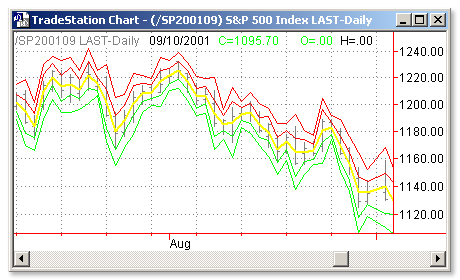Download: pivot1.ela
File Includes:
Indicator - Resistance1
Indicator - Support1
Category: Indicator > Support & Resistance
Description:
This indicator plots support and resistance lines accroding to the artcile.
The pivot technique consists of five basic arithmetic and algebraic formulas and is founded in the very basis of technical analysis. The first formula, which provides the daily pivot, requires you to identify the previous day's high, low and closing (or settlement) price in any futures market. You must add these three figures together and divide the sum by three. This is known as the daily pivot. The daily pivot is used in all four of the other formulas that make up the pivot technique and is given the most emphasis when used in day trading.
The idea here is that you want to be long above the pivot and short below the pivot. However, the essence of day trading the pivot lies in going long when the market violates the pivot in a bull rally and going short when the market violates the pivot in a bear break or downward move. This is how active day traders use the pivot. And of course, the first time the pivot is violated on the upside or downside is most important. It is given less weight (that is, less attention) the more often it is violated throughout the trading day.
The other four formulas of the pivot technique provide two support levels in the market below the pivot and two resistance levels in the market above the pivot. The five pivot technique formulas are as follows:
Pivot = (H+L+C)/3
R1 (Resistance level 1) = 2 x P - L
S1 (Support level 1) = 2 x P - H
R2 (Resistance level 2) = (P - S1) + R1
S2 (Support level 2) = P - (R1 - S1)
Usage:
Go long when the market violates the pivot in a bull rally.
Go short when the market violates the pivot in a bear break or downward move.

No Inputs
Resistance1 ELA Code:
VAR: NUMB(0),OP(0),CLOSE8(0),HIGH8(0),LOW8(0),PIVOT8(0),
RANGE8(0),RES1A(0),RES2A(0),RES3A(0),SUPP1A(0),SUPP2A(0),
SUPP3A(0),PIVPLT(0);
OP = IFF(TIME = SESS1FIRSTBARTIME,BARNUMBER,OP[1]);
NUMB = IFF(TIME = SESS1ENDTIME,BARNUMBER-OP+1,NUMB[1]);
CLOSE8 = CLOSE;
HIGH8 = HIGHEST(HIGH,NUMB);
LOW8 = LOWEST(LOW,NUMB);
PIVOT8 = (HIGHEST(HIGH,NUMB)+LOWEST(LOW,NUMB) + CLOSE)/3;
RANGE8 = HIGHEST(HIGH,NUMB) - LOWEST(LOW,NUMB);
PIVPLT = IFF(TIME=SESS1ENDTIME,PIVOT8 ,PIVPLT[1]);
RES1A = IFF(TIME=SESS1ENDTIME,(2*PIVOT8)-LOW8,RES1A[1]);
SUPP1A = IFF(TIME=SESS1ENDTIME,(2*PIVOT8)-HIGH8,SUPP1A[1]);
RES2A = IFF(TIME=SESS1ENDTIME,(PIVOT8-SUPP1A)+RES1A,RES2A[1]);
SUPP2A = IFF(TIME=SESS1ENDTIME,PIVOT8-(RES1A-SUPP1A),SUPP2A[1]);
PLOT1(RES1A,"1ST RESIST");
PLOT2(RES2A,"2ND RESIST");
PLOT3(PIVPLT,"PIVOT");
Support1 ELA Code:
VAR: NUMB(0),OP(0),CLOSE8(0),HIGH8(0),LOW8(0),PIVOT8(0),
RANGE8(0),RES1A(0),RES2A(0),RES3A(0),
SUPP1A(0),SUPP2A(0),SUPP3A(0),PIVPLT(0);
OP = IFF(TIME = SESS1FIRSTBARTIME,BARNUMBER,OP[1]);
NUMB = IFF(TIME = SESS1ENDTIME,BARNUMBER-OP+1,NUMB[1]);
CLOSE8 = CLOSE;
HIGH8 = HIGHEST(HIGH,NUMB);
LOW8 = LOWEST(LOW,NUMB);
PIVOT8 = (HIGHEST(HIGH,NUMB)+LOWEST(LOW,NUMB) + CLOSE)/3;
RANGE8 = HIGHEST(HIGH,NUMB) - LOWEST(LOW,NUMB);
PIVPLT = IFF(TIME=SESS1ENDTIME,PIVOT8 ,PIVPLT[1]);
RES1A = IFF(TIME=SESS1ENDTIME,(2*PIVOT8)-LOW8,RES1A[1]);
SUPP1A = IFF(TIME=SESS1ENDTIME,(2*PIVOT8)-HIGH8,SUPP1A[1]);
RES2A = IFF(TIME=SESS1ENDTIME,(PIVOT8-SUPP1A)+RES1A,RES2A[1]);
SUPP2A = IFF(TIME=SESS1ENDTIME,PIVOT8-(RES1A-SUPP1A),SUPP2A[1]);
;
PLOT1(SUPP1A,"1ST SUPPORT");
PLOT2(SUPP2A,"2ND SUPPORT");